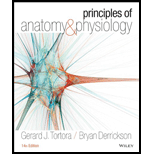
Principles of Anatomy and Physiology
14th Edition
ISBN: 9781118345009
Author: Gerard J. Tortora
Publisher: WILEY
expand_more
expand_more
format_list_bulleted
Question
Chapter 28, Problem 9CP
Summary Introduction
To review:
Sperm movement through the series of ducts starting from seminiferous tubules to the urethra.
Introduction:
Spermatogenesis is the process by which the sperms are produced in the seminiferous tubules. The sperm produced are non-motile and its movement through series of ducts starts in the fluid secreted by sustentacular cells.
Expert Solution & Answer
Want to see the full answer?
Check out a sample textbook solution
Students have asked these similar questions
What is the structure and function of Eukaryotic cells, including their organelles? How are Eukaryotic cells different than Prokaryotic cells, in terms of evolution which form of the cell might have came first? How do Eukaryotic cells become malignant (cancerous)?
What are the roles of DNA and proteins inside of the cell? What are the building blocks or molecular components of the DNA and proteins? How are proteins produced within the cell? What connection is there between DNA, proteins, and the cell cycle? What is the relationship between DNA, proteins, and Cancer?
Why cells go through various types of cell division and how eukaryotic cells control cell growth through the cell cycle control system?
Chapter 28 Solutions
Principles of Anatomy and Physiology
Ch. 28 - Prob. 1CPCh. 28 - Prob. 2CPCh. 28 - Describe the principal events of spermatogenesis.Ch. 28 - 29398-28-4CP-Q
Which part of a sperm cell contains...Ch. 28 - 29398-28-5CP-Q
What are the roles of FSH, LH,...Ch. 28 - Prob. 6CPCh. 28 - Describe the location, structure, and functions of...Ch. 28 - Prob. 8CPCh. 28 - Prob. 9CPCh. 28 - Prob. 10CP
Ch. 28 - Prob. 11CPCh. 28 - Prob. 12CPCh. 28 - Prob. 13CPCh. 28 - How are the ovaries held in position in the pelvic...Ch. 28 - Describe the microscopic structure and functions...Ch. 28 - 29398-28-16CP-Q
Describe the principal events of...Ch. 28 - Where are the uterine tubes located, and what is...Ch. 28 - What are the principal parts of the uterus? Where...Ch. 28 - Prob. 19CPCh. 28 - Prob. 20CPCh. 28 - Why is an abundant blood supply important to the...Ch. 28 - Prob. 22CPCh. 28 - What are the structures and functions of each part...Ch. 28 - Describe the components of the mammary glands and...Ch. 28 - 29398-28-25CP-Q
Outline the route milk takes from...Ch. 28 - Prob. 26CPCh. 28 - Briefly outline the major event of each phase of...Ch. 28 - 29398-28-28CP-Q
Prepare labelled diagram of the...Ch. 28 - Prob. 29CPCh. 28 - 29398-28-31CP-Q
How do some methods of birth...Ch. 28 - What is the problem with developing an oral...Ch. 28 - 32. Describe the role of hormones in...Ch. 28 - Prob. 33CPCh. 28 - Prob. 34CP
Knowledge Booster
Learn more about
Need a deep-dive on the concept behind this application? Look no further. Learn more about this topic, biology and related others by exploring similar questions and additional content below.Similar questions
- In one paragraph show how atoms and they're structure are related to the structure of dna and proteins. Talk about what atoms are. what they're made of, why chemical bonding is important to DNA?arrow_forwardWhat are the structure and properties of atoms and chemical bonds (especially how they relate to DNA and proteins).arrow_forwardThe Sentinel Cell: Nature’s Answer to Cancer?arrow_forward
- Molecular Biology Question You are working to characterize a novel protein in mice. Analysis shows that high levels of the primary transcript that codes for this protein are found in tissue from the brain, muscle, liver, and pancreas. However, an antibody that recognizes the C-terminal portion of the protein indicates that the protein is present in brain, muscle, and liver, but not in the pancreas. What is the most likely explanation for this result?arrow_forwardMolecular Biology Explain/discuss how “slow stop” and “quick/fast stop” mutants wereused to identify different protein involved in DNA replication in E. coli.arrow_forwardMolecular Biology Question A gene that codes for a protein was removed from a eukaryotic cell and inserted into a prokaryotic cell. Although the gene was successfully transcribed and translated, it produced a different protein than it produced in the eukaryotic cell. What is the most likely explanation?arrow_forward
- Molecular Biology LIST three characteristics of origins of replicationarrow_forwardMolecular Biology Question Please help. Thank you For E coli DNA polymerase III, give the structure and function of the b-clamp sub-complex. Describe how the structure of this sub-complex is important for it’s function.arrow_forwardMolecular Biology LIST three characteristics of DNA Polymerasesarrow_forward
arrow_back_ios
SEE MORE QUESTIONS
arrow_forward_ios
Recommended textbooks for you
 Human Physiology: From Cells to Systems (MindTap ...BiologyISBN:9781285866932Author:Lauralee SherwoodPublisher:Cengage Learning
Human Physiology: From Cells to Systems (MindTap ...BiologyISBN:9781285866932Author:Lauralee SherwoodPublisher:Cengage Learning Human Biology (MindTap Course List)BiologyISBN:9781305112100Author:Cecie Starr, Beverly McMillanPublisher:Cengage Learning
Human Biology (MindTap Course List)BiologyISBN:9781305112100Author:Cecie Starr, Beverly McMillanPublisher:Cengage Learning Concepts of BiologyBiologyISBN:9781938168116Author:Samantha Fowler, Rebecca Roush, James WisePublisher:OpenStax College
Concepts of BiologyBiologyISBN:9781938168116Author:Samantha Fowler, Rebecca Roush, James WisePublisher:OpenStax College Biology: The Dynamic Science (MindTap Course List)BiologyISBN:9781305389892Author:Peter J. Russell, Paul E. Hertz, Beverly McMillanPublisher:Cengage Learning
Biology: The Dynamic Science (MindTap Course List)BiologyISBN:9781305389892Author:Peter J. Russell, Paul E. Hertz, Beverly McMillanPublisher:Cengage Learning

Human Physiology: From Cells to Systems (MindTap ...
Biology
ISBN:9781285866932
Author:Lauralee Sherwood
Publisher:Cengage Learning

Human Biology (MindTap Course List)
Biology
ISBN:9781305112100
Author:Cecie Starr, Beverly McMillan
Publisher:Cengage Learning

Concepts of Biology
Biology
ISBN:9781938168116
Author:Samantha Fowler, Rebecca Roush, James Wise
Publisher:OpenStax College


Biology: The Dynamic Science (MindTap Course List)
Biology
ISBN:9781305389892
Author:Peter J. Russell, Paul E. Hertz, Beverly McMillan
Publisher:Cengage Learning

Reproduction: Crash Course Zoology #9; Author: CrashCourse;https://www.youtube.com/watch?v=poLyJDVjKlM;License: Standard youtube license